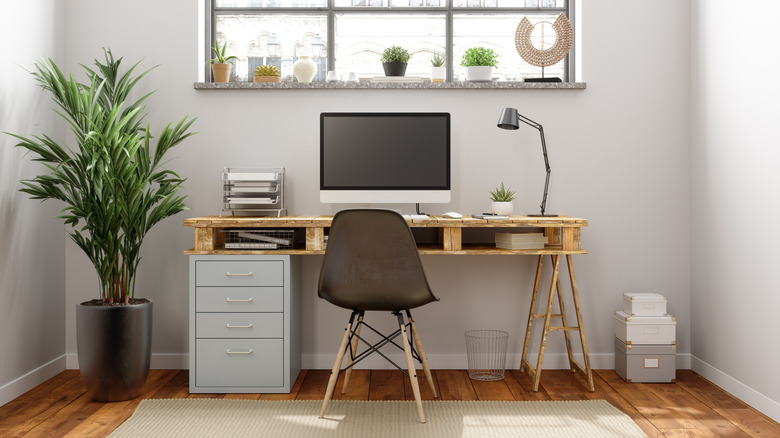A Psychologist's Best Tips For Separating Your Work & Home Life (Even If You WFH)
The modern world operates on a 24/7 timetable, making it difficult to separate areas of life at times. While technology is a miraculous tool, it can also lead to blurred lines when it comes to creating a division between work and life. This is especially true if you work from home and your living space doubles as your professional workspace. Whether you have kids running around while you try to juggle a project for work, you're trying to make more time for hobbies but have difficulty turning your office email notifications off, or the various areas of your life simply seem as stuck together as opposing colors of Play-Doh, you aren't alone.
Achieving a separation between your work and home life often seems easy in thought, but ends up being near impossible to implement. And treating work-life balance as an achievement isn't actually the best way to approach the concept, reveals Harvard Business Review. Instead, the process is a cycle that needs to be maintained.
In an exclusive chat with Glam, Dr. Paulette Sherman, a psychologist who has authored 26 books about relationships and lifestyle balance, and host of "The Love Psychologist" podcast, shared tips for figuring out what a work-life maintenance cycle should look like for you and how you can keep the balance going after you've established effective routines.
Have a ritual to transition between work and home headspaces
As you set out to create a separation between work and home, the primary principle to follow is to be intentional and conscious about your actions and commitments. "We are in different states of consciousness when we are in work mode than when we are relaxing at home, or at least we should be," Dr. Sherman told Glam exclusively. "Sometimes it is hard to switch over from head to heart unless we pause and do it intentionally. This could mean taking a walk, doing a meditation, or something that helps us shift after work."
The habit you choose to consciously divide your working headspace from your home life can be mini-rituals that take form in very simple means, such as changing your clothes or listening to a specific song. These actions are reserved solely for the transitional time between work and home.
If you need more than a handful of minutes to decompress and make the switch, you might consider creating a full playlist, watching a video, calling a friend, or getting outside into fresh air for an oxytocin-inducing walk or workout of your choice.
Keep to a consistent work schedule and communicate it to others
Establishing a healthy, productive work-life balance can be a struggle for anyone who juggles work, home, and the many realms in between, but creating a division is often particularly difficult for those who work from home. Being in the same place for your entire day comes with its own set of idiosyncrasies.
Speaking exclusively to Glam, Dr. Sherman said, "It is helpful if you have parameters in your work life when it is in the same place as your home." She recommends bringing your family, roommates, and household members into the conversation about creating of your work-life balance. Meaning, create a work schedule and let the other people in your household know the exact hours you'll be in your zone. "This alerts you and your family of your needs and boundaries," Dr. Sherman added.
Elaborating on this practice, Dr. Sherman said, "it is important not to let work bleed into all areas or having a weekend won't mean anything. Without the physical separation of work and home, this becomes easier to do." Ultimately, creating and sticking to a schedule is your greatest tool for determining when you'll be working and when you'll be available for downtime.
Have a certain area associated with work
If you work from home and don't have a brick-and-mortar office to travel to and from each day, it's critical to pay attention to the details of the workspace you put together for yourself. With WFH jobs, part of your home turns into your office while you're on the clock, so being mindful, intentional, and wise about how you set up your professional perimeter is a huge component of creating separation between work and home experiences.
"Your space can affect your psyche, relationships, and even your health," Dr. Sherman told Glam exclusively. "Create an office area — even better if it's closed off — so the rest of your space feels relaxing and therefore work is not on your mind when you are sleeping or socializing." Following these methods can allow you to be increasingly present when respectively focused on work and home.
An added benefit of prohibiting professional endeavors in your sleeping space, and keeping electronics out of your bedroom in the process, is that you'll establish quality sleep care habits and get a better night's rest, which will ultimately allow your work-life balance to be more easily maintained.
Turn off the electronics
When working from home, one of the most vital reminders is to turn your electronics off when you finish your professional responsibilities for the day. Switching off your computer, signing out of email, and powering down any other work-related electronic devices will limit your exposure to blue light, therefore promoting healthy sleep hygiene, and allow you to be more focused and present when you're in home mode.
Speaking about how technology encourages constant connection, which stimulates an indefinite workday void of boundaries, Dr. Sherman told Glam exclusively, "if coworkers are reaching you via a work phone or computer, it may be good to turn it off after work hours if possible, to create a real division of work and home life. If this is not possible, do not treat every communication as an emergency." Basically, give yourself permission to power down guilt-free.
It is understandably anxiety-inducing when you hear notifications from work come through during your off hours, but by embracing mindfulness practices and being aware of your reactive state, calming yourself through self-regulation, and being astute to the urgency of the correspondence sent after hours, you'll likely find your outlook improved and a greater sense of peace within your work-life balance. "Breathe and assess the best way to address it and to be present with your loved ones. See if you need to respond, when, and how," Dr. Sherman recommends.
Create pockets of time to be present and focus on loved ones
Perhaps the greatest benefit of separating work and home life is your ability to thoroughly enjoy being with family and friends without constantly shifting your headspace to work mode. Dr. Sherman told Glam in an exclusive chat that designating time aligned with your values can elevate the quality of time spent with those closest to you. "You can have a weekly date night or a family day on the weekend that becomes ritualized," she said. If your partner is also on a journey to maintain a work-life balance, Dr. Sherman recommended establishing guidelines about specific activities being strictly work-free. "You may have dinner together or breakfast, with the understanding that you are not working during those times," she said.
Along the lines of powering down electronics and setting them aside, you could implement the practice of having a basket for everyone to place their phones and other technological devices into prior to sitting down at the table for a shared meal. Communication is extremely important in maintaining a healthy work-life balance for everyone in the household, so you may consider establishing technology curfews or intentionally establishing times for enjoying non-screen-based activities.
Time spent connecting with yourself is equally important. "In my book, 'The Book of Sacred Baths,' I have a 20-minute bath ritual which helps you wash away the work day and center in love and peace," Dr. Sherman said.





